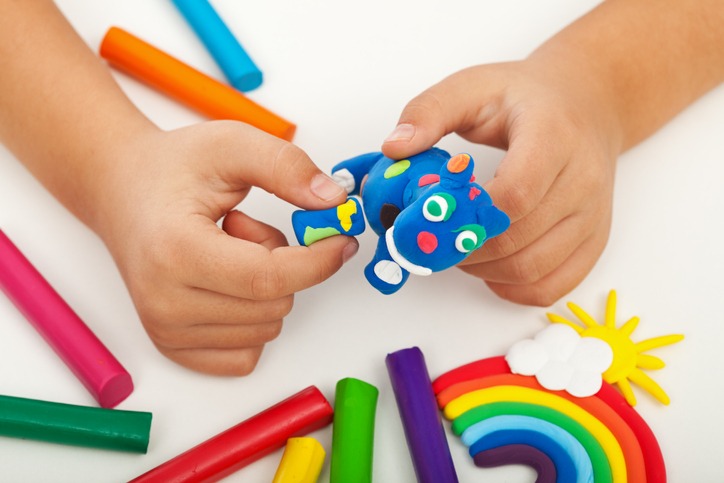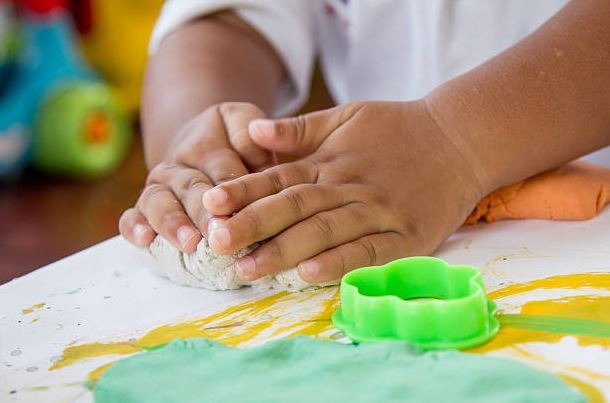When the name “Play-Doh is mentioned,” a bright yellow container with a colorful lid appears somewhere in our mind. More than that, the word – play-doh triggers a sensory memory in our minds; the soft and pliable material in bright colors and a fruity scent. And the taste of course – the redolent aroma urged almost every child to sample it at least once.
Play-Doh is the kind of toy that needs no introduction; everyone knows what it is and what it’s used for. Playdough being a modeling clay compound is no secret, but what most people do not know is how it was created in the first place.
Well, that’s where things get interesting. Playdoh wasn’t originally meant to be a play toy, let alone be used in arts and crafts education. The invention of play-doh is not more than just an accident. Stick with us as we unfold the shocking story behind the history of play-doh.
History of Play-Doh
You might not believe it but Play-Doh was present and used in almost all the houses even before it was considered a toy for kids. Before Play-Doh was named Play-Doh, the compound was used as a wallpaper cleaner.
Kutol Products – The Origin of Play-Doh
Tim Walsh mentioned in his book Timeless Toys that, during the 20s, Cincinnati (an Ohio-based Kutol Products soap company) was about to go bankrupt when Cleo McVicker – the 21-year old CEO decided to sell off the company’s assets to avoid bankruptcy. Although his idea managed to keep the company out of hot waters, the profits were insignificant.
In 1933, Cleo McVicker and his brother Noah managed to make a deal with Kroger grocery stores. The agreement was to make ready-made wallpaper cleaners sold and marketed at their stores.
Although the company had never manufactured wallpaper cleaner before, the formula introduced by Noah McVicker became a success. The wallpaper cleaner was made out of flour, salt, and water and the final product was a non-toxic, clay-like, malleable compound.
The wallpaper cleaner was quite a success and kept the company stable for almost twenty years; however, the sales started to fluctuate during the early 50s, with the advent of oil and gas. Oil and gas had replaced coal, and wallpapers didn’t get as dirty as before, which caused the sale of wallpaper cleaner to plummet.
The Foundation of Rainbow Crafts Company
In 1949, after Cleo’s death, Joseph McVicker took over the company. This was the time when Kay Zufall, McVicker’s sister-in-law – a nursery school teacher, noticed how modeling projects made out of wallpaper cleaner could be the next big thing. She convinced him to formulate a toy that kids can use to craft out different shapes. She also suggested the name to be Play-Doh. Joseph then thought over the idea and decided to repurpose and reformulate the wallpaper cleaner formula. The space and heavy-duty were the same; however, the final product was a toy instead of wallpaper cleaner.
In 1956, Joseph McVicker founded the Rainbow Crafts Company Inc. This was a subsidiary of Kutol products, and the products manufactured by it were repackaged. The product manufactured by Rainbow Crafts was named Play-Doh and was marketed in elementary schools throughout the greater Cincinnati area.
The company introduced Play-Doh in many different colors, including blue, yellow, and red in a year. The product was quite famous among schools. However, Joseph McVicker wanted a larger audience for his product, but the lack of budget was a problem. This was when Joseph’s creativity helped him again.
Play-Doh’s Road to Fame
McVicker decided to introduce the product to Bob Keeshan, also known as Captain Kangaroo. The toy was then marketed on “Ding Dong School,” “Romper Room,” and the most popular children’s show, “Captain Kangaroo.” The deal’s agreement suggested that if Captain Kangaroo features play-doh once a week, 2% of the sales generated that week would go to the production company. And the sales skyrocketed after that.
In 1960, McVicker hired two engineers who designed a multi-purpose product named the Fun Factory. The Fun Factory allowed the kids to create several shapes and designs without putting in too much force. This turned out to be a huge success. While the Kutol products were selling the wallpaper cleaner for 34 cents, they charged $1.50 for a can of paly-doh carrying just about the same material inside.
Play-Doh as a Worldwide Phenomenon
The plastic toy received such a widescale adoption in the US that by 1964, the company was exporting more than a million cans of play-doh to countries like Italy, France, and Britain. In 1965, the company was bought by General Mills for 3 million dollars, while in 1971, Kenner Products and Rainbow Crafts merged, and later Tonka Corporation bought both companies. In 1980, the packaging was changed, and the cardboard cans were replaced with plastic containers. Later in 1991, Hasbro bought the company and continues to manufacture Play-Doh to this date.
Play-Doh’s wide popularity earned it a place in the Strong’s National Toy Hall of Fame in 1998. In 2003, Play-Doh was listed in the “Century of Toys List” by the Toy Industry Association. By the year 2005, this fun toy had reached a supply of 95 million cans to more than 75 countries throughout the world.
The Fortune Magazine reveals that, since its debut in 1956, play-doh has sold up to 3 billion doh cans which accounts for more than 700 million pounds. In simpler terms, if you put that much play-doh through the fun factory playset of a snake, you could wrap it around the earth more than 300 times.
Some Fun Facts About Play-Doh

Like any other fascinating invention, Play-Doh also has fun facts that most people don’t know about. They are as follows:
- Play-Doh wasn’t intended to be an art/craft toy for children at first. It was used as a wallpaper cleaner until the 50s when oil, gas, and vinyl wallpapers emerged in the market.
- Play-Doh, when first launched, was not available in so many colors as today. It only came in only white color. However, later, new colors were introduced.
- Captain Kangaroo was the reason why Play-Doh became so famous. After a deal with McVicker, Captain Kangaroo used Play-Doh in his show, and soon after that, it became one of the most bought toys in the US.
- Play-Doh is not made out of some weird chemicals but from food ingredients. The main ingredients of the dough include flour, salt, and water.
- There is a larger-than-life Play-Doh in Disney’s Pop Century Resort. The hotel has a vintage Play-Doh container along with Play-Doh Pete in it.
Why is Play-Doh So Popular?
Since 1970, over 950 million pounds of Play-Doh have been sold, resulting in it becoming one of the most famous toys worldwide. Unlike video games and other complicated gadgets, Play-Doh is maybe the most creative and wholesome way of learning and playing at the same time.
Learning with Play-Doh was always the central concept of the toy, and even today, the purpose is alive. The Play-Doh playsets brought a lot of fame to the toy as they allowed the kids to experience the fun of creating new things. Play-Doh is still popular due to its several benefits in the learning phase of kids.
Learning with Play-Doh
Learning with Play-Doh supports the learning and development of a kid in several ways. Children who play with Play-Doh are most likely to explore their creativity and have more ideas than the kids who don’t involve in such learning. Playing in groups with Play-Doh allows the kids to compare, contrast, communicate and be artistic. Play-Doh enables kids to satisfy their curiosity and come up with new ideas. We can say that learning with Play-Doh is an exercise for young minds to be more creative.
Moreover, Play-Doh learning also allows the children to be more competent and be proud of what they are good at. Squeezing, rolling, and pounding the Play-Doh lets the extra energy go in safe outlets.
FAQs: The Interesting History of Play-Doh
1. Who invented Play-Doh?
Kay Zuffal, Joseph McVicker’s sister and nursery teacher, was the first to manufacture play-doh using wallpaper cleaner. She shared the idea with Joseph McVicker, who, with the help of his uncle Noah McVicker started manufacturing Play-Doh commercially under the banner of Rainbow Crafts Company Inc.
2. What was the original color Play-Doh?
Until 1956, play-doh only had one primary color – white. Other colors like blue, red, and yellow were also added to make it more presentable to kids. Play-Doh is available in multiple colors today, including rose red, purple paradise, blue lagoon, and garden green.
3. What ingredients are used to make Play-Doh?
The primary ingredients used in Play-Doh manufacturing are; flour, salt, and water. It might appear edible just now, but mineral oil boric acid was added to make it softer and pliable. Although the compounds are non-toxic, children should be cautioned from devouring them.
Conclusion
Play-Doh is a sign of nostalgia, which, when mentioned, brings hundreds of memories from childhood. For most of the 90s kids, Play-Doh was a part of their childhood. Even today, almost every pre-school uses the Play-Doh learning trick to help the kids develop more creativity and other social skills. A product that wasn’t even meant to be a toy at first became a significant part of millions of childhoods all around the world.
While squishing, rolling, and making things with Play-Doh, kids make memories, make their ideas come to life, and connect. From our point of view, the main reason behind the popularity of Play-Doh was the productivity and mind-development that it offers to the kids who play with it. We can bet that you, as an adult, also love to play with Play-Doh and create stuff because the kid inside us is always ready to do some fun stuff.

